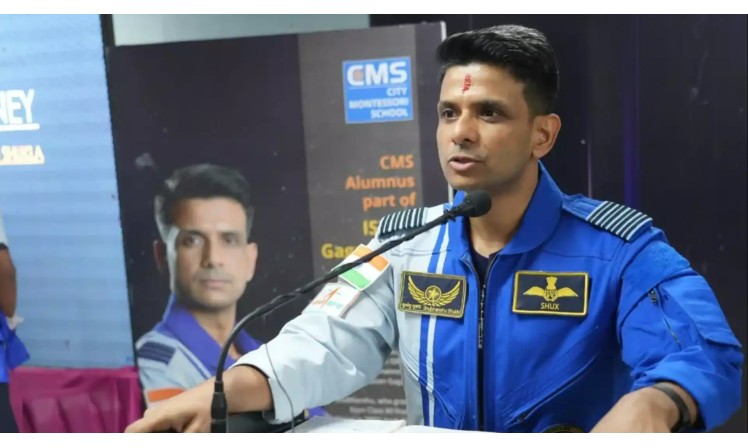
Image Source: Agencies
Aug 25, 2025: Undergoing survival tests in simulated environment, learning photography to document space experience and a team kayaking off the Mexican coast to foster camaraderie, these were some of the activities that the crew of Axiom-4 had engaged in before setting off on the mission, astronaut Shubhanshu Shukla said.
On Sunday, Group Captain Shukla, who goes by the call sign "Shux," talked about the training he received in advance of the Axiom-4 mission to the International Space Station (ISS) as well as the difficulties he encountered during that time. On June 25, the Dragon spacecraft carrying him and the other three astronauts was launched from the Kennedy Space Center in the United States, despite numerous delays. It literally shakes every bone in your body because it was so potent. You go from 0 km/hr to 28,500 km/hr in 8.5 minutes, which speaks to its magnitude,” Shukla recalled the intense lift-off experience. People in India and all over the world cheered for the mission as it was launched, and they did the same when the spacecraft splashed down upon their return to Earth on July 15. Lucknow-born Shukla became the first Indian astronaut to travel to the ISS and described the experience of the mission as “very exhilarating”.
During the event hosted by the Indian Air Force at the Subroto Park here, he also shared some anecdotes from his 20-day space sojourn as part of the mission that was preceded by several months of hard training.
It's like moving into a new house when you go to an ISS. Additionally, it has its own set of guidelines, including what you should eat and how you should sleep. “How would you go to a bathroom in space?” Shukla asked, causing laughter from the audience. Actually, going to a bathroom in space is the most difficult task. The astronaut, who will turn 40 this October 10, was commissioned into the IAF in 2006 and went on to become a decorated test pilot with over 2,000 hours of flying time on advanced fighter aircraft such as the Su-30 MKI, MiG-29, Jaguar, and Dornier-228.
Shukla grew up "shy and reserved," having grown up hearing stories about Rakesh Sharma's 1984 spaceflight. In addition, he obliged the fellow air warriors queuing up to get a picture with him at the event and signed autographs for school students, proving that life has indeed come full circle for him, just like his recent space excursion. He told the agencies, "Oh, it feels wonderful to see the excitement among students for space and India's space programme," when asked how this transformation felt. His profile in the Axiom-4 mission was that of a mission pilot, alongside commander Peggy Whitson of the US and mission specialists Slawosz Uznanski-Wisniewski of Poland and Tibor Kapu of Hungary.
“You are expected to interact with the displays and the capsule itself as a mission pilot. Therefore, your training is somewhat more challenging than that of the mission specialist,” he stated. Shukla recalled the training experience, which included time spent at NASA's Johnson Space Center in Houston. He stated that the difficulty in space is that assistance is scarce, so one must learn everything on the ground. And, for the past one year, this experience has been “nothing short of wonderful”, he said.
“You must be trained as a medical professional to administer first aid, as an engineer to perform maintenance, as a scientist to conduct experiments, and simultaneously learn photography, videography, and how to speak on camera because everything you do is your responsibility. There is nobody there who is going to come and assist you,” the Indian astronaut said.
Shukla conducted seven India-led microgravity experiments across diverse domains of life sciences, agriculture, space biotechnology, and cognitive research.
“I believe we had around 20 classes on photography and videography because, when you go up there, you want to bring back memories and snapshots to share with others in the future. I'm hoping I did a good job, he said. Shukla also showed a few videos of his training routine and a brief clip of what he tried to capture on camera of India as seen from space. “And, India does look really beautiful. I don't just say this because we are all Indians and we are sitting here; I also think that if you talk to any astronaut on the station, you will agree. The unique positioning and the shape, especially during night, if you pass over India, from the Indian Ocean, south to north, I think it is probably one of the most beautiful sights that you can ever see in your life,” he said.
Shukla recalling the celestial experience said, from the orbit, the crew saw sunrise and sunset, 16 times a day, and “you never get bored of it”.
He said that in addition to survival tests in a simulated environment for crew members, an exercise was also conducted to foster camaraderie and team spirit among them, highlighting the diversity of the team, which each member belonged to a different country and culture. So, he said, "I really enjoyed it" when a team kayaked off a beautiful Mexican coast. You must work as part of a team. If you are not a team player, you are not fit for spaceflight. because it fails," Shukla emphasized. He emphasized that as in an IAF training, the majority of time in space training is what “would you do if something goes wrong”.
Leave a comment: (Your email will not be published)